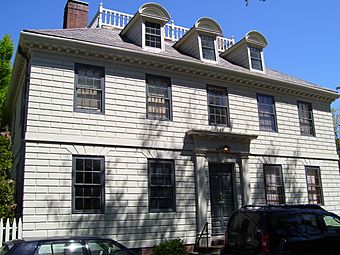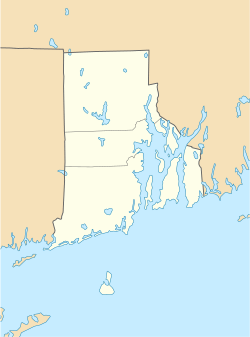Vernon House facts for kids
|
Vernon House
|
|
|
U.S. National Historic Landmark District
Contributing Property |
|
 |
|
| Location | 46 Clarke Street, Newport, Rhode Island |
|---|---|
| Area | less than one acre |
| Built | 1700 |
| Architectural style | Georgian |
| Part of | Newport Historic District (ID68000001) |
| NRHP reference No. | 68000005 |
Quick facts for kids Significant dates |
|
| Added to NRHP | November 24, 1968 |
| Designated NHL | November 24, 1968 |
| Designated NHLDCP | November 24, 1968 |
The Vernon House is a very old and important house in Newport, Rhode Island. It was built a long time ago, probably in the late 1600s, and changed a bit in the 1700s. This house became famous during the American Revolutionary War. From 1780 to 1783, it was the main office for the Comte de Rochambeau. He was the leader of the French soldiers who helped America fight for independence. Because of its history, the house was named a National Historic Landmark in 1968.
Contents
What the Vernon House Looks Like
The Vernon House is a two-and-a-half-story building made of wood. It has a special roof that is flat on top with a low fence around it. Small windows, called dormers, stick out from the roof on the front and sides. The ones on the front have rounded tops, while the side ones have pointed tops.
Two brick chimneys rise from inside the house. The front of the house has five windows or doors across, and it is four windows deep. The main front door is right in the middle. It has fancy columns on each side and a decorated top. The back door has a similar, but simpler, design.
Exterior Details
The outside of the house is covered in wood that looks like stone blocks. It's carved and painted to trick your eye! This stone-like look even includes special "keystone" shapes above the first-floor windows on the front. There's also a fake "belt" line between the first and second floors, making it look even more like a stone building.
Inside the House
The inside of the house mostly looks like it did after some big changes were made in 1759. It has a main hallway in the middle with two rooms on each side. The central hallway has beautiful wooden decorations. There's an arch supported by large fancy brackets, and the lower part of the walls is covered in wood panels. The ceiling has a decorative border with tooth-like shapes. These same fancy details are also found in the hallway on the second floor.
The main rooms downstairs also have similar wooden decorations and very detailed fireplaces. In one room, there's an old painting on the wall. It shows scenes from Chinese courts and Buddhist stories. On the second floor, there used to be paintings of the West Indies, but those are gone now.
History of the Vernon House
Most of the house's current look comes from a big renovation in 1759. This renovation made it one of the best examples of Georgian architecture in the city. Georgian architecture was a popular style in the 1700s, known for its balanced and grand designs.
Early Owners
The original building, before the 1759 changes, was probably built around the early 1700s. Records show that a painter named William Gibbs owned the house in 1708. His family kept the house until 1744.
In 1759, a man named Charles Bowler sold the property to his son, Metcalf Bowler. Metcalf was a merchant and a judge in the colonial supreme court. It's believed that the house was made much bigger and grander shortly after Metcalf bought it.
Revolutionary War Headquarters
In 1773, Metcalf Bowler sold the house to another merchant named William Vernon. When French soldiers arrived in Newport in 1780 during the American Revolutionary War, William Vernon offered his house to their commander, the Comte de Rochambeau. This is why the house is so famous! Rochambeau used it as his headquarters, or main office, during the war.
The Vernon family owned the house for a long time, until 1872. In 1912, a charity bought the house to save it from being torn down. They did some repairs to it. For many years, it was used as the office for the Family Service Society. Then, in 1966, it was sold back to private owners.
In 1968, the Vernon House was officially recognized as a National Historic Landmark. It was also added to the National Register of Historic Places. This means it's a very important historical site in the United States.
Gallery






